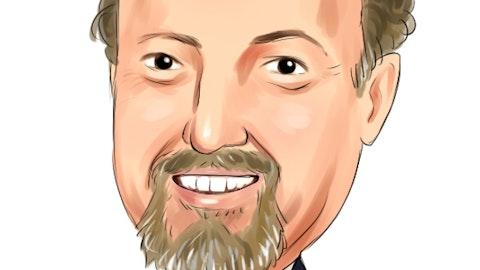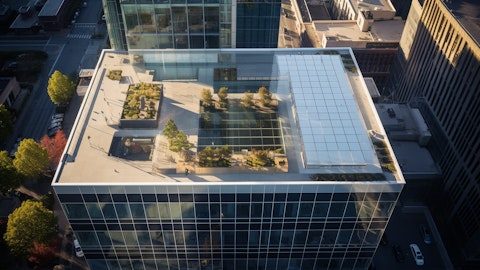Owen Thomas: Yes. I think the — Alex, to answer your question on the debt side, Mike should answer. But in general, as you know, we primarily finance with unsecured financing, and we have great access to that market and have been accessing it and we think it’s very attractive. And in most cases, we’ve been able to extend or refinance existing mortgages that we have on our joint ventures. Look, I think in terms of the answer to your question, the JV partners would have to answer it in terms of how they thought about the returns that they were forecasting from the extensions that we committed to. But when we do our own math, and we shared some of it with you on this call, we think it’s very attractive and it’s very accretive to our company, and we think it makes a lot of sense.
So our suspicion, as a result, is that these decisions that they made were more related to a change in strategy as opposed to a lack of enthusiasm for the return. I’d also just make an additional point on this. These are two different partners, and they come from a little bit different position. So the partner on 901 has been a long-term investor in that project, and they have been in it, and they have made a good return and has been very successful for them. So maybe it was a change in strategy, but it also might have been, look, we’ve been in this for a very long period of time. We’ve done fine. Maybe this would be a good time to exit. I think on the partner on the other two deals, Santa Monica Business Park and 360, definitely, they were newer to the JVs, and I think that clearly was more of a change in strategy.
Operator: Thank you. And I show our next question comes from the line of Nick Yulico from Scotiabank. Please go ahead.
Nicholas Yulico: Thank you. I was hoping to just get a little bit more feel for the decision to reinvest in Santa Monica Business Park. Why you think it’s still an attractive long-term opportunity? And secondly, if you could just give us any feel for — in terms of the Snap renewal, how the mark-to-market worked on that plus the level of TIs and free rent if you had to give there?
Owen Thomas: Yes. So I’ll turn it over to Mike for the second question. But in terms of the first question, I mentioned the yield that we bought this and the per foot that we bought the asset on a fee simple basis, we think that’s very attractive pricing. We were able to derisk the asset materially through the extension of the anchor tenant, which leases 400-plus thousand square feet of the 1.2 million square feet. And also, we think that Santa Monica Business Park is a very interesting redevelopment opportunity for our company, and we’re in the process of commencing that redevelopment process. And we think over a long period of time, it’s going to be a very accretive asset to our company. So we are excited about the asset.
Douglas Linde: Yes. And Nick, this is Doug. On your answer to the other question. Without — we’re not going to get into the specifics of a particular tenants economics. As I said in my remarks, our West Coast leases that were signed this quarter — executed this quarter was down 3%, but San Francisco was up 9%. So you can go through the statistics and sort of decide yourself how you think that might have played out. And relative to transaction costs in free rent, it was actually a very low transaction costs and low free rent early renewals. So those economics were built into the lease rate.
Operator: Thank you. And I show our next question comes from the line of Anthony Paolone from JPMorgan. Please go ahead.
Anthony Paolone: Thanks, good morning. You talked about playing offense and it sounds like you’ll use some third-party capital as you’ve done in the past. But just for BXP’s portion of deals and playing offense, where do you think we see capital come from for you all?
Owen Thomas: Well, as you said, as I mentioned in my remarks, I do think there will be opportunities that will present themselves for the company this coming year. And as you said, we will — the joint venture partner more than likely using third-party capital, and we will be using our balance sheet to fund our joint venture interest in whatever we come up with. But it’s — again, we are receiving inquiries. We are looking at things, but we’re not, I would say, advanced in anything at this time. But if we look at what we think will happen in 2024 versus illiquidity in the market in 2023, I think activity will be greater this coming year.
Michael LaBelle: And I would just add that a lot of what we’re looking at is doing things more on a capital-light basis, and taking a lower percentage interest percentage potentially or entering assets in a different way and kind of similar to these transactions that we did, and this didn’t require a lot of incremental capital. We took on a little bit, obviously, their share of the debt, but the overall impact on our leverage was very, very small with these transactions. And in fact, we’ve kind of delevered overall because we brought in the equity from the Cambridge transaction. Overall, we deleverage. We’re — we don’t expect that we’re going to increase our leverage significantly. And our goal is to kind of maintain it in a range that is pretty close to where we are. So I think that when we think about investments, we keep that in mind.
Operator: Thank you. And I show our next question comes from the line of Michael Goldsmith from UBS. Please go ahead.
Michael Goldsmith: Good morning. Thanks a lot for taking my questions. We’ve talked a little bit about San Francisco, and there’s some clear differences in the markets. Do you think we’re kind of hitting the bottom in these tech markets that are lagging in their portfolio? And just any visibility from the demand from AI or other sources that are providing some near-term excitement for a rebound in San Francisco and Seattle?
Douglas Linde: I would say, Michael, that the technology demand on the West Coast is lower than we would like it to be, largely because there have been a significant amount of technology layoffs over the past, call it, 12 to 18 months, and they’re still happening. Clearly, they’re happening at a much lower rate and they’re on the margin. So I would tell you that I think we’ve been sort of in the “bottom” for a period of time. And I don’t look at the world and say that there’s another “shoe to drop”, I think we’re just sort of in a portion of time where there’s just no interest in growth from a real estate space perspective for technology companies. I believe that will change. The fourth quarter and the third quarter of 2023 in San Francisco for AI was a great quarter, and we had 2 really interesting transactions occur, which we’ve described previously.
There was 1 million square feet of positive absorption. I’m not smart enough to know if those 2 tenants may double or triple or quadruple over the next 2 to 3 years. I also don’t know whether or not there are going to be other AI companies that are either BC or seed invested with angel investing that are going to explode. I’m hopeful that those types of things will happen. And from our perspective, that will all be to the good for the West Coast and for the city of San Francisco. 2024 is not going to be that year in terms of, in our view, space absorption.




